CHERRIES and RIPEET: CWTS traveling the Science - Society interface
This blogpost presents how CWTS got involved in two H2020-funded projects, CHERRIES and RIPEET, what they are about (territorial RRI), what we have learned from it, and what our contribution was (and still is) to developing interactions between science and society.
Looking back
At the STI conference 2018 in Leiden, two strands of work at CWTS, the Responsible Research and Innovation (RRI) work in the MoRRi project, and the regional knowledge patterns for innovation, got together. We realized that RRI (demand driven, contextual engagement in R&I) and the policy to focus on regional strength (smart specialization) could be complementary and should be developed in a concerted way in regions. This happened to be the topic of the Horizon 2020 Science with and for Society (SwafS) 14 call on ‘Territorial RRI’. In 2020 (CHERRIES) and 2021 (RIPEET) two H2020 3-year territorial RRI projects were granted, in which CWTS is partnering.
CHERRIES and RIPEET
CHERRIES is about experiments in Responsible Healthcare systems. The main question is how CHERRIES experiments can help investigate opportunities and challenges that are associated with the role of need and demand within the healthcare sector. CHERRIES has 11 partners from 7 European countries – Austria, Belgium, Italy, the Netherlands, the Republic of Cyprus, Spain and Sweden. Coordinated by ZSI (AT), the consortium brings together heterogeneous actors of the innovation ecosystem, including small and medium enterprises, research institutions, universities, territorial authorities, a hospital and a Civil Society Organisation to collectively reflect on and design policy experiments around enabling Responsible Research and Innovation (RRI) in the healthcare sector in three European territories: in Murcia (ES), Örebro (SE) and the Republic of Cyprus (CY).
RIPEET is about Responsible energy transition policy experiments. The purpose of RIPEET is to support territories in establishing experimental spaces to address the territorial dimensions of the European Green Deal. RRI-based Transition Labs will create collective stewardship of the territorial energy future via participatory instruments and serve as a framework for envisioning sustainable energy futures. RIPEET has 11 partners from 7 European countries – Austria, Belgium, Finland, Italy, Netherlands, Spain and the UK. Coordinated by ZSI (AT), the consortium brings together quintuple helix actors (policy, industry, academia, civil society and the environment); the team is highly inter- and transdisciplinary, building on long lasting experiences in RRI, territorial innovation and smart specialisation strategies and energy policy and research. The (RRI) policy experimentations for energy transition is investigated in three European territories - in Extremadura (ES), Highlands and Islands of Scotland (UK) and Ostrobothnia (FI).
In the remainder of the blogpost we will introduce:
- The CHERRIES model, and where RIPEET is different;
- The tasks that CWTS is involved in based upon our expertise;
- The learnings of CWTS on working at the science-society interface;
- What we do different in RIPEET, and how our work has developed into a methodology, EXPLORE, which will be described in more detail in our next blogpost.
The CHERRIES Model
The CHERRIES team aimed to mobilise territorial stakeholder ecosystems and engaged them into regional pilot actions, applying an RRI framework. The pilot actions include:
- identify needs in the healthcare sector at territorial level (through a call for needs);
- encourage the proposition and co-creation of innovative solutions to the identified needs (call for solutions);
- stimulate institutional reflection processes on how to innovate products and services in the healthcare sector through participatory approaches;
- present evidence-based recommendations for revision of sectoral policies, strategies and innovation support instruments.
The CHERRIES model (below) is based upon co-creation activities with stakeholders, and testing in the regions. The model works well to effectively develop targeted innovations and provide legitimacy and motivation through inclusion and engagement. However, it still lacks strategic directionality and misses anchoring in regional processes.
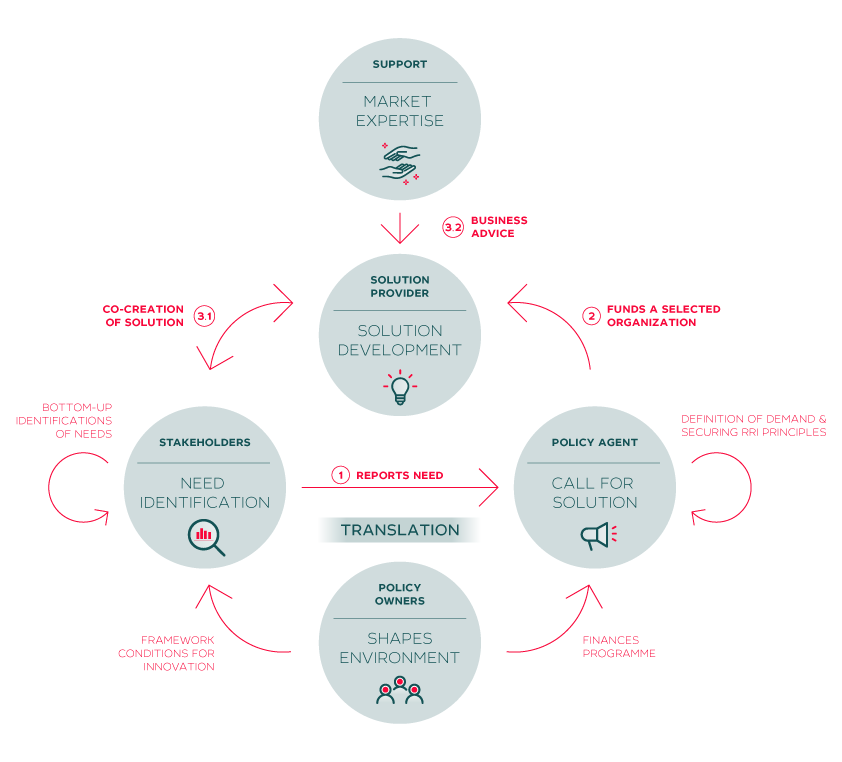
In the figures below, the topics of the healthcare innovation in the three CHERRIES regions are depicted. Each of these pilot actions as such is carried out by local actors in a democratised fashion.
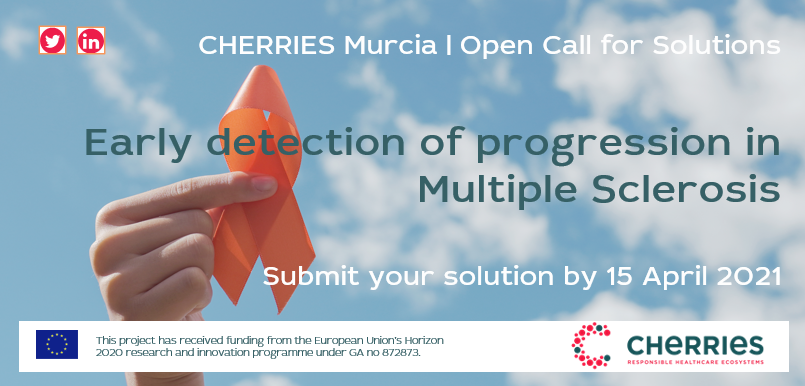
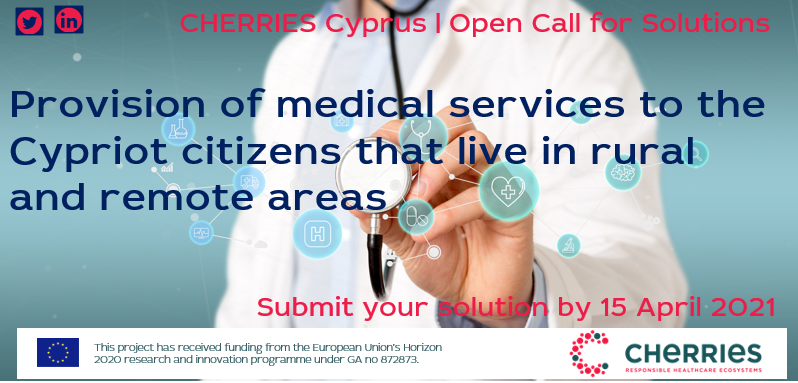
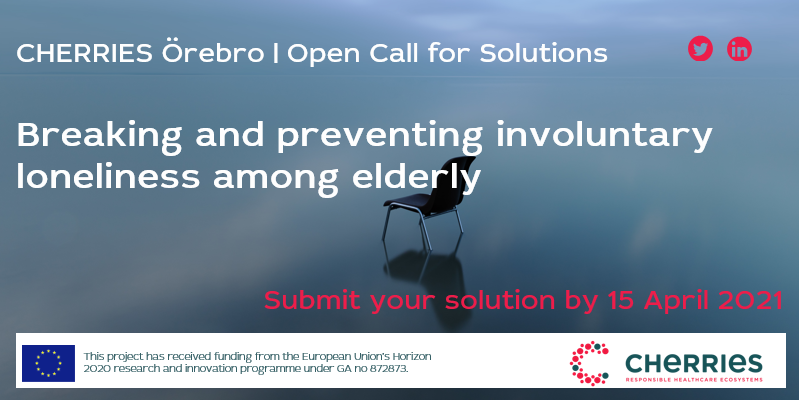
RIPEET follows a largely similar approach with some changes. In RIPEET, the regions each form a so-called Transition Lab, which is based on the evolutionary model of socio-technical transitions (Geels and Schot, 2007). The Energy Transition Labs (ETL) aim to set up spaces for learning, interaction and interconnection between key actors (government, civil society, industry, academia) to collaboratively produce knowledge about the current problems of the energy sector, the preferred future scenarios, and possible strategies to achieve a sustainable vision. It includes joined reflection, visioning, and back casting before arriving at the needs identification and call for solutions which was just launched (September 2022).
CWTS tasks in CHERRIES and RIPEET
In CHERRIES, the role of CWTS is on tasks where the project can benefit from our expertise in RRI and regional innovation. We are involved in the mapping of existing local knowledge, qualitative work regarding the local policy mix and the project’s overall impact assessment / evaluation.
The mapping included a) identification of regional stakeholders in healthcare, research, policy, and industry; b) collecting (national and regional) policies on smart specialisation, RRI aspects (including those reflecting the RRI-keys, such as Public Engagement, Ethics, Open Access, Gender Equality, Science communication and governance) and healthcare innovation; and c) mapping of regional science and technology strengths based upon bibliometrics and project analysis. The rationale for the latter being that regional innovation benefits from local strengths.
The policy approach in CHERRIES departed from the idea how technological change (invention, innovation, diffusion) is faced with multiple market, system and institutional failures and thus requires multi-faceted policy interventions (Weber and Rohracher, 2012). A policy mix which combines several policy instruments would be the response to this challenge. However, during the project, the interactive sessions with the regional partners on policy revolved around two major, related, issues that are prerequisites for developing appropriate policy mixes: How can we develop arenas for deliberation that bring together stakeholders from different backgrounds to allow them to discuss policy jointly, and how can we make the pilot actions sustainable? As with many projects, there is no answer to what comes after the pilot.
The monitoring and evaluation (M&E) is currently ongoing. The focus is on M&E of the territorial experimentations led by the local partners and the overall impact assessment of CHERRIES as a project. In addition, M&E activities take into consideration the translational abilities of an interventionist project like CHERRIES locally and the changes these can trigger. Hence, M&E is both inward and outward looking. It builds upon systematic collection of information in bi-monthly evaluation sessions with the regional partners on how implementation of smart specialisation and RRI is taking place, complemented with a site visit and evaluative conversations with stakeholders beyond the regional partners to assess how CHERRIES may have affected or even changed local policy and practice.
In RIPEET, CWTS is involved in similar tasks.
The learnings of CWTS on working at the science-society interface
Since 2014, CWTS is involved in Responsible Research and Innovation (RRI), through a range of activities and H2020-funded projects (e.g. MoRRI, NewHoRRIzon, SUPER MoRRI) bringing together R&I partners across Europe knowledgeable on RRI from different perspectives. Often these partners are universities, research institutes or not-for-profit research organisations, for which ‘the project’ is an instrument to do research whilst engaging with others in the field. In CHERRIES, 3 partners represent such a research background, of which CWTS is one. The aim of the RRI projects funded through the (SwafS) programme from an EC perspective is to bring RRI to the region, or to implement the European-oriented RRI policy in regional contexts. One of the major learnings is that there is a big gap between ‘a policy’ (RRI in this case) and bringing it to life in actual research and innovation practices. While co-creation is put central, projects such as CHERRIES and RIPEET require translation between the stakeholders involved and their diverse needs and wishes and the researchers in the projects. Stakeholders occupy different worlds and want and need different things from our projects. It is important to become aware of this diversity. Drawing on Michel Callon’s sociology of translation, several challenges needed to be addressed in the ‘problematization, involvement, enrollment and representation’ in CHERRIES: Who actually defines the regional healthcare problem? Project partners, stakeholders, funder? When involving and engaging with non-academic stakeholders: who takes ownership of processes, what are power dynamics and how do we include diversity? And thirdly, how do we translate projects into representative and effective narratives and indicators, that fit with the local needs and contexts. One of the major conclusions is that RRI as a policy when put into practice is operationalized differently in different contexts, and that these contexts should lead the way. The action research approach we eventually developed around evaluative conversations works well.
What we do different in RIPEET
Whilst CHERRIES and RIPEET are different in their topic (healthcare and energy transition) and regional partners, they are similar in their set-up and approach. Because we started with RIPEET exactly a year later, we at CWTS were able to improve how to connect our contribution to the rest of the project. This was particularly relevant since in CHERRIES we realised that preparing a mapping, including bibliometrics, goes well beyond the interest and understanding of the partners. In other words, to make our contribution useful for our partners and beyond, we as well should translate the needs and adjust our work. In RIPEET, we therefore worked much more demand-driven, leaving the lead to the regional partners, as the mapping should serve their purpose, and not necessarily our own ideas. So the mapping exercise became an integral part of the Transition labs, and was co-created with the local partners. Interestingly, the joint mapping, in an iterative process, resulted in partly similar topics of attention (CWTS and region), but also additional ones that were shaped by local context and needs, and also, types of partners involved in the process. As such, the ownership of the mapping process was better accounted for.
Our work, combining mapping and evaluative conversations to serve both RRI and Smart Specialisation (a regional innovation policy) has developed into a methodology, EXPLORE, which will be described in more detail in our next blogpost.
In conclusion, the territorial RRI projects have allowed us to travel and explore the science-society interface by engaging with local non-academic stakeholders from the start; to become embedded action researchers in a co-creative process, and to realise that it takes a lot of effort to bring science out of its own world to society.






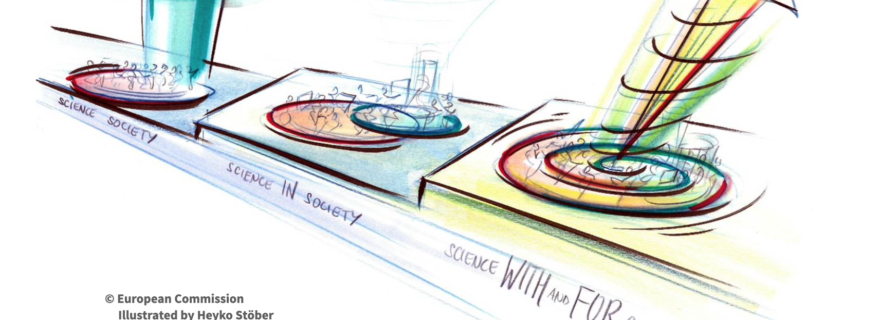
0 Comments
Add a comment